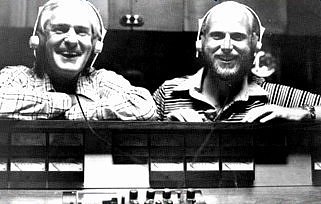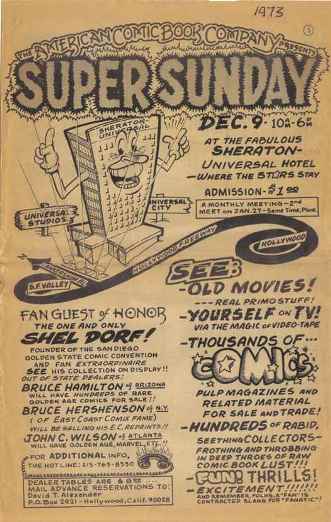By Barry Alfonso

Dr. Timothy Leary (left) and Gabriel Wisdom in 1976
The San Diego Comic Convention hosted many stellar guests during its first decade, but perhaps the most unlikely among them was psychedelic guru Dr. Timothy Leary. Once labeled by Richard Nixon as “the most dangerous man in America,” he was still a notorious figure when he attended the 1976 Comic-Con. Not everyone on the Con committee was thrilled to have him there. Nevertheless, he did play a small but memorable part in the program. I know: I acted as his assistant, temporary sidekick and cohort in pranksterism.
Leary’s Comic-Con experience came about through the efforts of Gabriel Wisdom, at that time a popular air personality on San Diego’s KGB-FM. Gabriel was a supporter of the Con and had hosted its masquerade dressed up as the Mighty Thor, whom he had portrayed on television in Hawaii some years earlier. It seems that Leary had begun listening to Gabriel’s program while serving out his sentence at the San Diego Metropolitan Correctional Center. Tim contacted him and the two became friends. Gabriel envisioned Leary becoming a contributor to a new program called Conversations with Higher Intelligence. Leary, in turn, hoped to re-launch himself as a pundit of the New Consciousness – an effort that a radio platform could only help. After his release in the spring of 1976, he was ready to put his plans into action.
As the publicity director for the Comic-Con, I had turned to Gabriel as a mentor in developing my media relations skills. One day in mid-‘76, he called me and asked if I’d like to help him in a project involving Leary. Why I was selected for this mission seemed a bit unclear – I think the two of them liked the idea of having a youngster on board.
We first met at Leary’s new home in San Diego’s Mission Hills neighborhood. Gabriel, Tim and his then-wife Joanna Harcourt-Smith were there. I accepted the invitation to participate in various interviews/skits involving science or consciousness expansion or whatever – the whole thing was a little nebulous to me at that point. For some reason, the song “Winner/Loser” (from the Steve Winwood/Stomu Yamashta/Michael Shrieve album Go) was brought up. Leary objected to the fatalistic Buddhist attitude expressed in its lyrics – it didn’t gibe with his forward-looking, ultra-positive philosophy. I started to get the sense that Leary had some big ideas he wanted to advance over the airwaves, no matter how kooky his methods might seem on the surface.
Not long after that, we all met down at KGB studios for some initial recording. Leary wanted to use this program to promote concepts like genetic engineering, human longevity and space travel and enjoyed using unorthodox methods to do it. He and Gabriel started calling up various famous people and attempted to interview them for the show. Among them was scientist Carl Sagan, who suddenly came over the studio speakers one afternoon. I got on the phone line and spoke to him in the guise of David Phipps, who in real life was a renowned young physicist. Sagan was not amused by this charade – he apparently didn’t think much of Leary and felt he’d been roped into something he didn’t want to participate in. It wasn’t a very productive dialogue.
Perhaps the most memorable incident at the KGB sessions was the moment Leary put his hands around my throat and pretended to strangle me. I had said in passing that I liked Bob Dylan’s music, which elicited Tim’s mock-rage. (I learned later from Gabriel that Leary had known Dylan and thought he was a dark, withdrawn sort of person whose songs promoted negativity.) It was all meant in fun, though I did feel I had stepped into a vortex of counterculture rivalry.
Around the time this was going on, Gabriel approached the Comic-Con committee about having Leary as a guest that year. I remember a somewhat contentious meeting on this subject, with Richard Butner and myself speaking in favor of inviting Leary and Shel Dorf very much against the idea. Shel mentioned that representatives of the Edgar Rice Burroughs estate had heard about the possibility of Leary attending and threatened to not participate in the Con if he did so. We finally voted to invite him, though Shel was still concerned that the Comic-Con’s reputation would be hurt by the good doctor’s presence.
As it turned out, Tim didn’t have any negative impact on the Con that I could detect. Some people were not pleased, but overall he got along quite well with the guests and attendees. He decked himself out in a white hat with a small light-emitting diode on it and assumed the role of “Commodore Leri,” an agent of the future. It helped him to fit in with all the other fantastic characters crowding the El Cortez Hotel hallways.
I can recall hanging out by the hotel swimming pool with Leary, who sat shirtless and looked liked any other grey-haired, middle aged white guy on vacation. Still, no matter how low-key he was, you could sense something that set Leary apart – he had a definite raffish charisma. There was also a slight wariness about him that I attributed to his years in prison. No doubt he was simply getting used to being out of jail. (He did have a sense of humor about his ex-con status – while he lounged poolside, my mother sat nearby with a badge that read “parole officer.” I’m sure Leary noticed.)
Leary spoke as part of a Comic-Con panel with Gene Roddenberry, among others. (Gabriel remembers this was on the topic of Star Wars, which premiered at that year’s Con.) He added some unexpected zest to the proceedings – it’s easy to imagine writers and filmmakers getting a kick out of his predictions about the amazing future he saw ahead for us. The science-fiction element of the Comic-Con program fit right in with Leary’s interests. In truth, he was like some swashbuckling scientist character out of a novel or film – the hero or the villain, depending upon your point of view.
The oddest moment of Leary’s Comic-Con experience was the press conference he held in one of the El Cortez’s conference rooms. Tim, Gabriel and I sat at a table and faced a room of 20 or so reporters. My job was to manipulate the controls of an electronics panel, receive “messages from outer space” and whisper them into Leary’s ear before he answered a question. The media people weren’t very amused by this routine; some were openly hostile. I think one reporter said (more or less), “Cut the crap – now that you’re out, are you going to start peddling LSD again?” Leary used this occasion to advance his futuristic ideas, not caring how irritated his audience became. I just sat there spinning my dials, enjoying my part in this curious show.
The rest of my (you’ll pardon the expression) flashbacks of Dr. Leary are fragmentary: escorting him down the convention stairs, introducing him to friends, watching how he carried himself among admirers and detractors. He was good with people, with his broad smile and rascally charm. Leary was obviously something of a party animal, but he also seemed undeniably brilliant – subversively so. He projected the air of a man privy to secrets and able to see into the future. The wheeler-dealer and the prophet coexisted within him.
From what I understand, Leary enjoyed his time at the Comic-Con. He went on to become a regular on Gabriel’s “Brainstorm” syndicated radio show, made nightclub appearances as a “stand-up philosopher” and toured with old nemesis G. Gordon Liddy. It’s interesting that both he and Chuck Norris helped gain early exposure for their show business careers at the San Diego Comic-Convention. Too bad they never got to make a movie together.
While I stayed in touch with Gabriel after the 1976 Comic-Con, I never saw Leary again. I can’t say he totally transformed me – and no, he didn’t slip anything into my drink. But spending time with him and watching him mess with people’s minds was definitely a trip I’ll never forget.
(Special thanks to Gabriel Wisdom for sharing his memories of Leary and SDCC’76.)
Barry Alfonso is a professional writer living in Pittsburgh. His work has appeared in such publications as Rolling Stone, the L.A. Times and Songwriter. His liner notes for the Peter, Paul and Mary box set Carry It On were nominated for a Grammy. These days, he is a music reviewer for iTunes and is working on an assortment of book projects. In addition, he has written songs recorded by Pam Tillis (‘In Between Dances,” a Number One country single), the Highwaymen (Johnny Cash, Willie Nelson, Waylon Jennings and Kris Kristofferson), Trisha Yearwood and Kathy Mattea. In earlier days, at the age of twelve in the fall of 1969, Barry was one of a group of five young comic fans who joined with Shel Dorf to start the San Diego Comic-Con.
To read Timothy Leary’s own account of one radio-recording session with Gabriel Wisdom and Barry, visit http://www.planetpootwaddle.com/timothy_leary.html. However, please note that the “the fifteen-year old boy” referred to therein was actually the eighteen-year old Barry.
